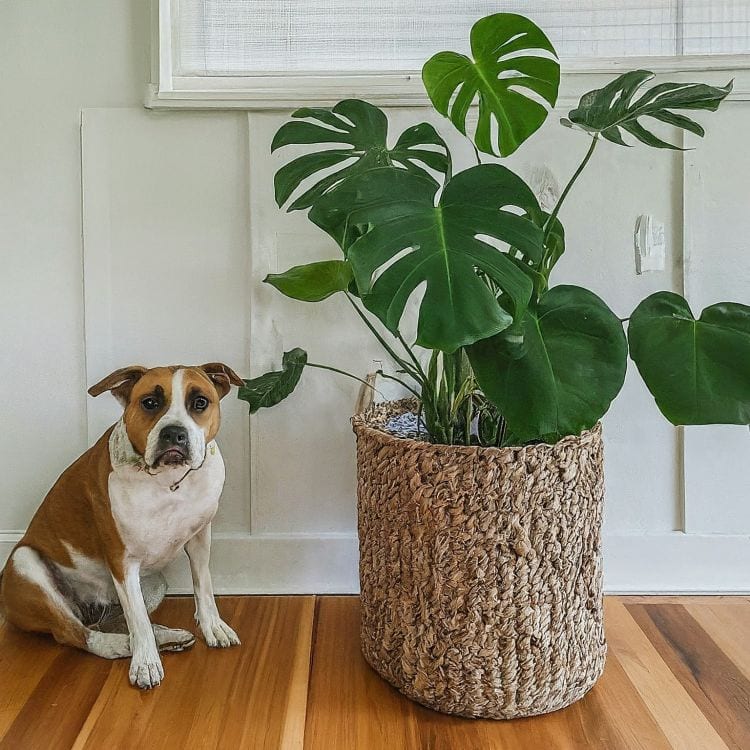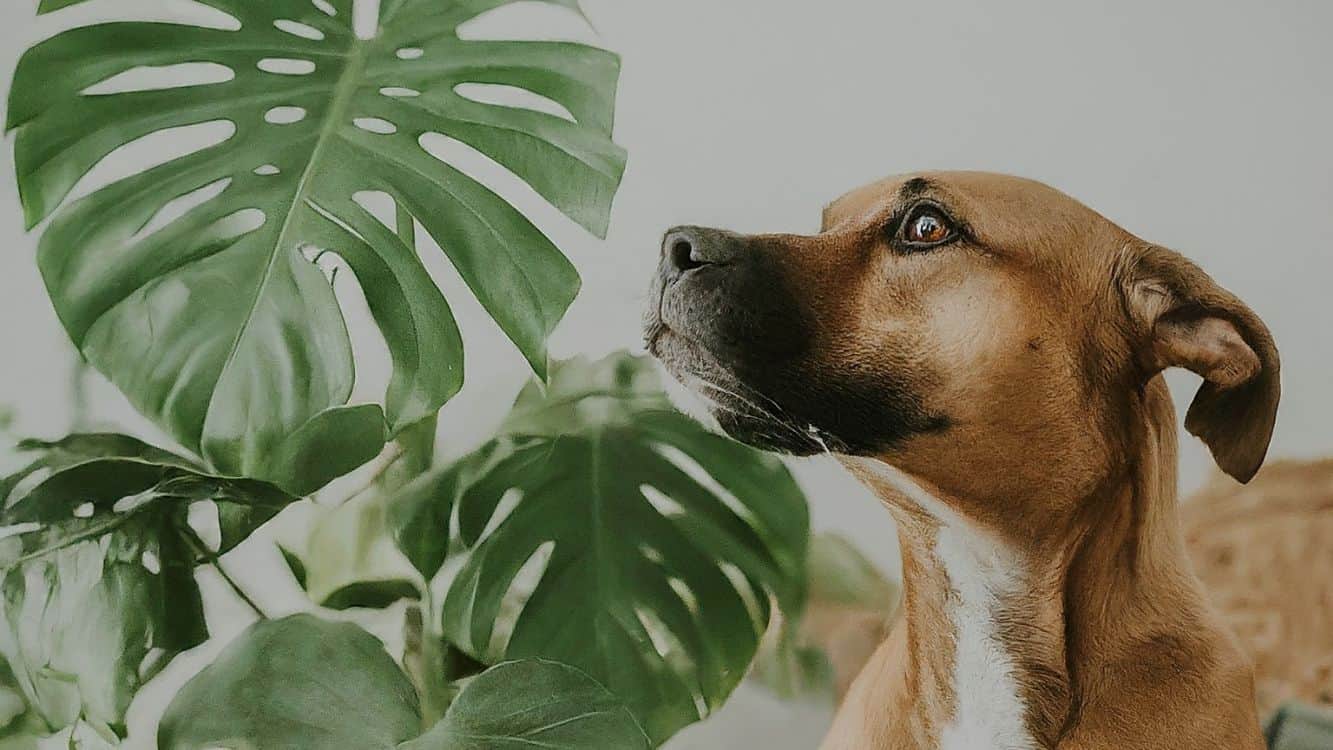Monstera plants, famous for their funky split leaves and tropical vibe, are all the rage among indoor plant fans. But if you’ve got a furry friend at home, you might be wondering: Is the Monstera plant toxic to dogs’ tummies? Knowing what to watch out for can help keep your pup safe and happy.
The good news is that Monstera plants usually won’t make your dog seriously sick. If they take a nibble, it might just bother their mouth, throat, and tummy a bit, maybe causing them to throw up or drool. But they should be fine as long as they don’t chow down on a huge amount of the plant.
Still, it’s essential to keep an eye on your pup around Monstera plants. Dogs are curious creatures, and they might decide to taste-test anything within reach. So, it’s a good idea to put your Monstera in a spot where your dog can’t get to it easily, like on a high shelf or in a room they don’t go into. Remember, too much of anything can be a bad thing. Even though Monstera plants aren’t super dangerous to dogs, it’s always best to discourage them from munching on any plants. That way, you can enjoy your leafy green decor without worrying about your furry friend getting an upset stomach.
Contents
- 1 Why is the Monstera Plant Toxic to Dogs?
- 2 Which Parts of the Monstera Plant Toxic to Dogs?
- 3 Could Monstera Plants Pose a Lethal Threat to My Dog?
- 4 Symptoms of Ingestion
- 5 Prevention
- 6 Safer Plant Options for Dogs Friendly Environments
- 7 FAQs
- 7.1 Is the Monstera plant toxic to dogs?
- 7.2 What parts of the Monstera plant are toxic to dogs?
- 7.3 Could Monstera plants pose a lethal threat to my dog?
- 7.4 What are the symptoms of ingestion of the Monstera plant by dogs?
- 7.5 How can I prevent my dog from being exposed to Monstera plant toxicity?
- 7.6 Are there safer plant options for homes with dogs?
- 8 Keeping Your Dogs Safe
- 9 Author
Why is the Monstera Plant Toxic to Dogs?

Calcium oxalate crystals are microscopic structures found in various plants, including the Monstera plant. These crystals serve as a natural defense mechanism for the plant against herbivores. When an animal, such as a dog, chews on or ingests parts of a Monstera plant, these sharp, needle-like crystals can cause irritation and discomfort in the mouth, throat, and digestive tract.
In the case of Monstera plants, calcium oxalate crystals are primarily concentrated in the plant’s leaves. When a dog chews on or ingests these leaves, the crystals can come into contact with the sensitive tissues of the mouth and throat, leading to irritation and inflammation. This irritation may manifest as pawing, drooling, or vocalizing discomfort.
If the dog swallows parts of the Monstera plant containing calcium oxalate crystals, the crystals can also cause irritation and inflammation along the digestive tract. This can result in symptoms such as vomiting, diarrhea, and abdominal pain. While calcium oxalate crystals in Monstera plants are not typically life-threatening to dogs, they can cause significant discomfort and should be avoided.
Dog owners must be aware of the potential risks associated with their pets coming into contact with Monstera plants, as they are toxic to dogs, and take preventive measures to keep their furry friends safe.
Which Parts of the Monstera Plant Toxic to Dogs?

Leaves
The leaves of the Monstera plant contain the highest concentration of calcium oxalate crystals, making them the most potential part of the Monstera plant toxic to dogs if ingested. These sharp, needle-like crystals serve as a natural defense mechanism for the plant against herbivores. When a dog chews on or ingests Monstera leaves, the crystals can cause irritation and discomfort in the mouth, throat, and digestive tract.
Stems
While the stems of the Monstera plant may also contain calcium oxalate crystals, they typically have a lower concentration than the leaves. However, ingestion of stems by dogs can still lead to irritation and discomfort in the mouth and digestive tract. While less common than leaf ingestion, dog owners need to be aware of the potential risks associated with their pets coming into contact with Monstera stems.
Roots
The roots of the Monstera plant may contain trace amounts of calcium oxalate crystals, although they are not as concentrated as the leaves of the Monstera plant toxic for dogs. Ingestion of Monstera roots by dogs is less likely compared to leaves and stems, but it can still lead to mild irritation in the mouth and digestive tract. While the risk is lower, it’s still advisable for dog owners to prevent their pets from chewing on or ingesting Monstera roots to avoid potential health issues.
Could Monstera Plants Pose a Lethal Threat to My Dog?
In most scenarios, the answer is no.
Ingesting sections of a Monstera plant is unlikely to result in fatality for a dog unless they consume huge quantities. While an excess of calcium oxalate crystals within a dog’s system could potentially lead to kidney damage, such instances are extremely rare. Typically, the immediate discomfort caused by these crystals acts as a deterrent, dissuading animals from further ingestion of the plant.
However, as the Monstera plant is toxic to dogs, and should your dog ingest any portion of a Monstera plant, it is advisable to promptly seek veterinary attention.
Symptoms of Ingestion
If the dog ingests parts of a Monstera plant dog may experience these symptoms of toxicity as we know that the Monstera plant toxic to dogs. These symptoms can include:
Oral Irritation
Chewing on Monstera leaves can lead to irritation of the mouth, tongue, and throat. Dogs may exhibit signs of discomfort such as pawing, drooling, or vocalizing.
Gastrointestinal Distress
Swallowing plant material can result in gastrointestinal issues such as vomiting, diarrhea, and abdominal pain. In severe cases, dehydration and lethargy may also occur.
Respiratory Symptoms
In rare instances, inhalation of pollen or plant particles may cause respiratory distress, particularly in dogs with pre-existing respiratory conditions.
Treatment and Prevention
If you doubt that your dog ingests parts of a Monstera plant or is showing symptoms of toxicity, it’s crucial to seek veterinary care immediately. Treatment may involve supportive care to alleviate symptoms, such as intravenous fluids to prevent dehydration and medications to soothe gastrointestinal upset.
Prevention
Prevention is key to keeping dogs safe from plant toxicity. Here are some measures dog owners can take:
Plant Placement
Keep Monstera plants out of reach of dogs, either by placing them in elevated locations or using barriers to restrict access.
Supervision
Monitor your dog’s behavior around plants, especially if they have a habit of chewing on foliage.
Training
Train your dog to avoid chewing on plants by providing appropriate chew toys and reinforcing positive behaviors.
Plant Selection
Consider opting for pet-safe houseplants that pose minimal risk to dogs if ingested.
Safer Plant Options for Dogs Friendly Environments

After assessing the potential risks, you might decide against having both a dog and a Monstera plant in your home.
However, fear not! There is a plethora of stunning houseplants that are also safe for your furry companions:
- African violet
- Boston fern
- Burro’s tail
- Calathea
- Christmas cactus
- Cast iron plant
- Echevieria
- Haworthia
- Majesty palm
- Money tree
- Nerve plant
- Parlor palm
- Peperomia
- Pilea
- Polka dot plant
- Ponytail palm
- Prayer plant
- Rattlesnake plant
- Spider plants
Should you be concerned about cohabiting with your dog and plants, these alternatives offer a viable solution.
FAQs
Is the Monstera plant toxic to dogs?
Yes, it contains calcium oxalate crystals, which can cause irritation and discomfort if ingested by dogs. So it is true that monstera plant toxic to dogs.
What parts of the Monstera plant are toxic to dogs?
The leaves of the Monstera plant contain the highest concentration of calcium oxalate crystals, making them the most potential part of the Monstera plant toxic to dogs if ingested. Stems and roots may also contain these crystals but in lower concentrations.
Could Monstera plants pose a lethal threat to my dog?
In most scenarios, ingesting sections of a Monstera plant is unlikely to result in fatality for a dog unless they consumes huge quantities. While excess calcium oxalate crystals could potentially lead to kidney damage, such instances are extremely rare.
What are the symptoms of ingestion of the Monstera plant by dogs?
Symptoms of ingestion may include oral irritation, gastrointestinal distress (vomiting, diarrhea, abdominal pain), and in rare instances, respiratory symptoms. If you suspect ingestion, seek veterinary care immediately.
How can I prevent my dog from being exposed to Monstera plant toxicity?
Prevention is key. Keep Monstera plants out of reach of dogs, monitor their behavior around plants, and consider training them to avoid chewing on foliage. Opting for pet-safe houseplants can also reduce the risk.
Are there safer plant options for homes with dogs?
Yes, many stunning houseplants are safe for dogs if ingested. Some examples include African violet, Boston fern, Calathea, and Spider plants.
Keeping Your Dogs Safe
As responsible pet owners, it’s essential to prioritize the safety and well-being of our furry friends, especially when we know that the Monstera plant is toxic to dogs. With this knowledge in mind, it’s crucial to take proactive measures to prevent any potential harm. To prevent your dog from accessing your plants, consider situating them in areas that are inaccessible to your furry friend.
Placing them on elevated shelves or in hanging baskets, particularly for smaller varieties, can be effective. Alternatively, employing gates, chicken wire, or other barriers can serve as a deterrent. Another approach is to designate a room that your dog is not permitted to enter for housing your plants.
Moreover, promptly removing any fallen leaves can help deter your dog from viewing them as playthings.
If you need to ensure your dog stays away from your plants during your absence, confining them to a Monstera-free zone of your home or placing them in their crate can be practical measures.

